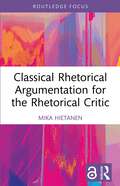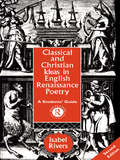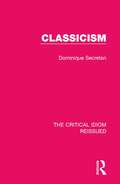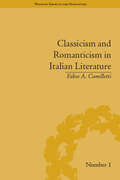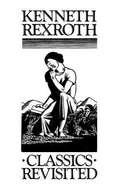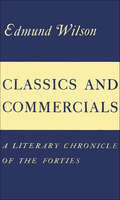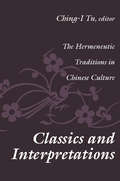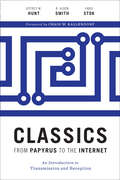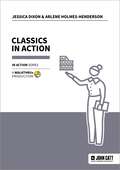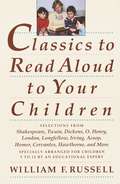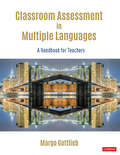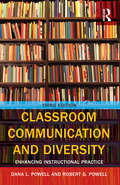- Table View
- List View
Classical Rhetorical Argumentation for the Rhetorical Critic (Routledge Studies in Rhetoric and Communication)
by Mika HietanenThis book offers a reassessment of argumentation in classical rhetoric, foregrounding its rational dimension. Moving beyond introductions, it provides insights from Aristotle, Quintilian, and other ancient thinkers while addressing common misconceptions and offering clarifications that are particularly valuable for the rhetorical critic.Adopting a Scandinavian rhetorical perspective, this book argues that classical rhetoric offers enduring tools for both the analysis and the construction of persuasive argumentation. By bridging theory and practice, it demonstrates how classical rhetoric remains highly relevant, while also naturally integrating with analyses that focus on classical concepts such as ethos, pathos, or style – whether through neo‑Aristotelian methods or contemporary approaches rooted in the classical rhetorical tradition. Key concepts are explored in dedicated chapters: the ‘art’ of logos‑based argumentation is reassessed; enthymeme and epicheireme structures are examined; and topoi and staseis are discussed in relation to their later developments. A chapter on the centenary of rhetorical criticism traces its evolution from Herbert Wichelns (1925) to today, proposing a new template for the rhetorical critic.This concise yet comprehensive book will interest intermediate and advanced students, as well as scholars of rhetoric, argumentation, persuasion, speech and writing studies, and communication studies.
Classical Samaritan Poetry
by Laura Suzanne LieberThis book introduces the evocative but largely unknown tradition of Samaritan religious poetry from late antiquity to a new audience. These verses provide a unique window into the Samaritan religious world during a formative period.Prepared by Laura Suzanne Lieber, this anthology presents annotated English translations of fifty-five Classical Samaritan poems. Lieber introduces each piece, placing it in context with Samaritan religious tradition, the geopolitical turmoil of Palestine in the fourth century CE, and the literary, liturgical, and performative conventions of the Eastern and Western Roman Empires, shared by Jews, Christians, and polytheists. These hymns, composed by three generations of poets—the priest Amram Dara; his son, Marqah; and Marqah’s son, Ninna, the last poet to write in Samaritan Aramaic in the period prior to the Muslim conquest—for recitation during the Samaritan Sabbath and festival liturgies remain a core element of Samaritan religious ritual to the present day.Shedding important new light on the Samaritans’ history and on the complicated connections between early Judaism, Christianity, the Samaritan community, and nascent Islam, this volume makes an important contribution to the reception of the history of the Hebrew Bible. It will appeal to a wide audience of students and scholars of the Hebrew Bible, the New Testament, early Judaism and early Christianity, and other religions of late antiquity.
Classical Samaritan Poetry
by Laura Suzanne LieberThis book introduces the evocative but largely unknown tradition of Samaritan religious poetry from late antiquity to a new audience. These verses provide a unique window into the Samaritan religious world during a formative period.Prepared by Laura Suzanne Lieber, this anthology presents annotated English translations of fifty-five Classical Samaritan poems. Lieber introduces each piece, placing it in context with Samaritan religious tradition, the geopolitical turmoil of Palestine in the fourth century CE, and the literary, liturgical, and performative conventions of the Eastern and Western Roman Empires, shared by Jews, Christians, and polytheists. These hymns, composed by three generations of poets—the priest Amram Dara; his son, Marqah; and Marqah’s son, Ninna, the last poet to write in Samaritan Aramaic in the period prior to the Muslim conquest—for recitation during the Samaritan Sabbath and festival liturgies remain a core element of Samaritan religious ritual to the present day.Shedding important new light on the Samaritans’ history and on the complicated connections between early Judaism, Christianity, the Samaritan community, and nascent Islam, this volume makes an important contribution to the reception of the history of the Hebrew Bible. It will appeal to a wide audience of students and scholars of the Hebrew Bible, the New Testament, early Judaism and early Christianity, and other religions of late antiquity.
Classical Storytelling and Contemporary Screenwriting: Aristotle and the Modern Scriptwriter
by Brian PriceSince we first arrived on the planet, we’ve been telling each other stories, whether of that morning’s great saber-tooth tiger hunt or the latest installment of the Star Wars saga. And throughout our history, despite differences of geography or culture, we’ve been telling those stories in essentially the same way. Why? Because there is a RIGHT way to tell a story, one built into our very DNA. In his seminal work Poetics, Aristotle identified the patterns and recurring elements that existed in the successful dramas of his time as he explored precisely why we tell stories, what makes a good one, and how to best tell them. In Classical Storytelling and Contemporary Screenwriting, Brian Price examines Aristotle’s conclusions in an entertaining and accessible way and then applies those guiding principles to the most modern of storytelling mediums, going from idea to story to structure to outline to final pages and beyond, covering every relevant screenwriting topic along the way. The result is a fresh new approach to the craft of screenwriting—one that’s only been around a scant 2,500 years or so—ideal for students and aspiring screenwriters who want a comprehensive step-by-step guide to writing a successful screenplay the way the pros do it.
Classical Victorians
by Edmund RichardsonVictorian Britain set out to make the ancient world its own. This is the story of how it failed. It is the story of the headmaster who bludgeoned his wife to death, then calmly sat down to his Latin. It is the story of the embittered classical prodigy who turned to gin and opium - and the virtuoso forger who fooled the greatest scholars of the age. It is a history of hope: a general who longed to be an Homeric hero, a bankrupt poet who longed to start a revolution. Victorian classicism was defined by hope - but shaped by uncertainty. Packed with forgotten characters and texts, with the roar of the burlesque-stage and the mud of the battlefield, this book offers a rich insight into nineteenth-century culture and society. It explores just how difficult it is to stake a claim on the past.
Classical and Christian Ideas in English Renaissance Poetry: A Students' Guide
by Isabel RiversSince publication in 1979 Isabel Rivers' sourcebook has established itself as the essential guide to English Renaissance poetry. It: provides an account of the main classical and Christian ideas, outlining their meaning, their origins and their transmission to the Renaissance; illustrates the ways in which Renaissance poetry drew on classical and Christian ideas; contains extracts from key classical and Christian texts and relates these to the extracts of the English poems which draw on them; includes suggestions for further reading, and an invaluable bibliographical appendix.
Classicism (The Critical Idiom Reissued #26)
by Dominique SecretanFirst published in 1972, this book provides an overview of Classicism in literature. After an informative introduction to the term, it explores some of the periods and places in which Classicism has been prominent: the Italian Renaissance, England before and during the Restoration, Renaissance France and eighteenth-century Germany. In avoiding a rigid definition of Classicism, this book demonstrates its multiplicity and changeability across time periods, as well as its limits.
Classicism and Other Phobias
by Dan-el Padilla PeraltaA provocative case for why immortalizing Greek and Roman culture as &“classical&” marginalizes and devalues Black lifeGreek and Roman antiquity has been enshrined in disciplines and curricula at all levels of education, perpetuating what the historian of political thought J.G.A. Pocock has called &“a conceptual dictatorship on the rest of the planet.&” Classicism and Other Phobias shows how the concept of &“classicism&” lacks the capacity to affirm the aesthetic value of Black life and asks whether a different kind of classicism—one of insurgence, fugitivity, and emancipation—is possible.Engaging with the work of Sylvia Wynter and other trailblazers in Black studies while drawing on his own experiences as a Black classicist, Dan-el Padilla Peralta situates the history of the classics in the racial and settler-colonialist settings of early modern and modern Europe and North America. He argues that immortalizing ancient Greek and Roman authors as &“the classical&” comes at the cost of devaluing Black forms of expression. Is a newfound emphasis on Black classicism the most effective counter to this phobia? In search of answers, Padilla Peralta ranges from the poetry of Juan de Castellanos to the writings of W.E.B. Du Bois and paintings by contemporary artists Kehinde Wiley and Harmonia Rosales.Based on the prestigious W.E.B. Du Bois Lectures delivered at Harvard University, Classicism and Other Phobias draws necessary attention to the inability of the classics as a field of study to fully cope with Blackness and Black people.
Classicism and Romanticism in Italian Literature: Leopardi's Discourse on Romantic Poetry (Warwick Series in the Humanities #1)
by Fabio A CamillettiIn 1816 a violent literary quarrel engulfed Bourbon Restoration Italy. On one side the Romantics wanted an opening up of Italian culture towards Europe, and on the other the Classicists favoured an inward-looking Italy. Giacomo Leopardi wrote a Discourse of an Italian on Romantic Poetry aiming to contribute to the debate from a new perspective.
Classics Revisited
by Kenneth Rexroth Bradford MorrowThe history of, and comments about, 60 classic pieces of literature, ranging from Gilgamesh to Huckleberry Finn.
Classics after Antiquity: Modernism and Homer
by Leah Culligan FlackThis comparative study crosses multiple cultures, traditions, genres, and languages in order to explore the particular importance of Homer in the emergence, development, and promotion of modernist writing. It shows how and why the Homeric epics served both modernist formal experimentation, including Pound's poetics of the fragment and Joyce's sprawling epic novel, and sociopolitical critiques, including H. D. 's analyses of the cultural origins of twentieth-century wars and Mandelstam's poetic defiance of the totalitarian Stalinist regime. The book counters a long critical tradition that has recruited Homer to consolidate, champion and, more recently, chastise an elitist, masculine modernist canon. Departing from the tradition of reading these texts in isolation as mythic engagements with the Homeric epics, Leah Flack argues that ongoing dialogues with Homer helped these writers to mount their distinct visions of a cosmopolitan post-war culture that would include them as artists working on the margins of the Western literary tradition.
Classics and Commercials: A Literary Chronicle of the Forties
by Edmund WilsonClassics and Commercials: A Literary Chronicle of the Forties showcases Edmund Wilson's critical writings spanning decades and continents. Many of these essays first appeared in the New Yorker.Here is Wilson on Jane Austen, Thackeray, Edith Wharton, Tolstoy, Swift (the classics) as well as brilliant observations on Poe, H.P Lovecraft, detective stories, and other commercial literature. This wide-ranging study from one of the most influential man of letters demonstrates Wilson's supreme skills as both literary and cultural critic.
Classics and Interpretations: The Hermeneutic Traditions in Chinese Culture
by Ching I TuIn recent years in the "West," scholars have attempted to unravel old constructs of interpretation and understanding, using the discipline of hermeneutics, or the scientific study of textual interpretation. Borrowed from students of the ever growing body of biblical interpretive literature that originated in the early Christian era, theoretical hermeneutics has given many contemporary scholars potent tools of textual interpretation. Classics and Interpretations applies this method to Chinese culture. Several essays focus on hermeneutic traditions of Neo-Confucianism. Others move outside of these traditions to attempt an understanding of the role of hermeneutics in Taoist and Buddhist textual interpretation, in Chinese poetics and painting, and in contemporary Chinese culture.This volume makes a concerted effort to remedy our ignorance of the Chinese hermeneutical tradition. Part 1, "The Great Learning and Hermeneutics," demonstrates the use of commentary to define how the individual creates his social self, and discusses differing interpretations of the Ta-hsueh text and its treatment as either canonical or heterodox. Part 2, "Canonicity and Orthodoxy," considers the philosophical touchstones employed by Neo-Confucian canonical exegetes and polemicists, and discusses the Han canonization of the scriptural Five Classics, while illuminating a double standard that existed in the hermeneutical regime of late imperial China. Part 3, "Hermeneutics as Politics," discusses the transformation of both the classics and scholars, and explores the dominant hermeneutic tradition in Chinese historiography, the scriptural tradition and reinterpretation of the Ch'un-ch'iu, and reveals the pragmatism of Chinese hermeneutics through comparison of the Sung debates over the Mencius. The concluding sections include essays on "Chu Hsi and Interpretation of Chinese Classics," "Hermeneutic Traditions in Chinese Poetics and Non-Confucian Contexts," "Reinterpretation of Confucian Texts in the Ming-Ch'ing Period," and "Contemporary Interpretations of Confucian Culture."Through these literate and brilliantly written essays the reader witnesses not merely the great breadth and depth of Chinese hermeneutics but also its continuity and evolutionary vigor. This volume will excite scholars of the Confucian, Buddhist, and Taoist systems of thought and belief as well as students of history and hermeneutics.
Classics for Pleasure
by Michael DirdaIn these delightful essays, Pulitzer Prize winner Dirda introduces nearly 90 of the world's most entertaining books, covering masterpieces of fantasy, science fiction, horror, adventure, epics, history, and children's literature.
Classics from Papyrus to the Internet: An Introduction to Transmission and Reception (Ashley and Peter Larkin Series in Greek and Roman Culture)
by R. Alden Smith Jeffrey M. HuntA &“valuable and useful&” history of the efforts and innovations that have kept ancient literary classics alive through the centuries (New England Classical Journal). Writing down the epic tales of the Trojan War and the wanderings of Odysseus in texts that became the Iliad and the Odyssey was a defining moment in the intellectual history of the West, a moment from which many current conventions and attitudes toward books can be traced. But how did texts originally written on papyrus in perhaps the eighth century BC survive across nearly three millennia, so that today people can read them electronically on a smartphone? Classics from Papyrus to the Internet provides a fresh, authoritative overview of the transmission and reception of classical texts from antiquity to the present. The authors begin with a discussion of ancient literacy, book production, papyrology, epigraphy, and scholarship, and then examine how classical texts were transmitted from the medieval period through the Renaissance and the Enlightenment to the modern era. They also address the question of reception, looking at how succeeding generations responded to classical texts, preserving some but not others. This sheds light on the origins of numerous scholarly disciplines that continue to shape our understanding of the past, as well as the determined effort required to keep the literary tradition alive. As a resource for students and scholars in fields such as classics, medieval studies, comparative literature, paleography, papyrology, and Egyptology, Classics from Papyrus to the Internet presents and discusses the major reference works and online professional tools for studying literary transmission.
Classics in Action
by Jessica Dixon Dr Arlene Holmes-HendersonClassics is one of the most varied and interdisciplinary of all subjects; it includes literature, history, philosophy, art and archaeology. There is growing interest among teachers in the subject, and recent studies have shown that learning Latin and/or Greek can have a positive impact on student outcomes in English and literacy.Jessica Dixon and Arlene Holmes-Henderson showcase ideas from their own teaching experience, plus innovative examples from a range of schools, to provide strategies for teaching Latin, Greek, Classical Civilisation and Ancient History that will enrich, enliven and extend your teaching practice.Inspiring and eye-opening, this will be an enjoyable and useful read for all teachers who are currently teaching, training to teach, or interested in teaching classical subjects and related disciplines, in primary or secondary schools.
Classics in Action
by Jessica Dixon Dr Arlene Holmes-HendersonClassics is one of the most varied and interdisciplinary of all subjects; it includes literature, history, philosophy, art and archaeology. There is growing interest among teachers in the subject, and recent studies have shown that learning Latin and/or Greek can have a positive impact on student outcomes in English and literacy.Jessica Dixon and Arlene Holmes-Henderson showcase ideas from their own teaching experience, plus innovative examples from a range of schools, to provide strategies for teaching Latin, Greek, Classical Civilisation and Ancient History that will enrich, enliven and extend your teaching practice.Inspiring and eye-opening, this will be an enjoyable and useful read for all teachers who are currently teaching, training to teach, or interested in teaching classical subjects and related disciplines, in primary or secondary schools.
Classics in Lesbian Studies
by Esther D RothblumClassics in Lesbian Studies takes a major step in giving the lesbian experience its own unique voice within scholarship and the larger world society. Thus, it is devoted exclusively to the lesbian experience and serves as a vehicle for the promotion of scholarship and commentary on lesbianism from an international perspective. Not only does it ensure that “classic” pieces are not forgotten by new generations of students and scholars, it also spurs further lesbian research, writing, theory, and scholarship.In Classics in Lesbian Studies, you are introduced to descriptive, theoretical, empirical, applied, and multicultural perspectives in the field of lesbian studies. Interdisciplinary, the book presents pieces from various academic areas in multiple formats, including personal accounts, poetry, editorials, debates, and commentaries. For your convenience, the chapters are organized primarily across four categories: identity, history and literature, physical and social sciences, and “back to lesbian politics.” You will find the discussions of the following issues and subjects provocative and insightful: ways black women in the diaspora construct and name their sexual and romantic feelings for other women lesbian identity formation in a changing social environment how lesbians maneuver in the dominant culture and their own subculture lesbianism as a political movement the experiences of lesbian adolescents teaching lesbian studies lesbians and societal institutions, including the work place, the media, the political arena, the legal system, and religion using lesbian-feminist scholarship to reexamine women's lives in the pastStudents, scholars, lesbian feminists, and others interested in lesbian studies will find Classics in Lesbian Studies a vital examination of lesbianism since its grass roots. Not only does it consider the progress made since the initial days of fighting for liberation, it also explores a more distant, repressed past and anticipates future possibilities lying before us. This powerful, insightful collection is sure to become a classic as it grapples with virtually all aspects of lesbianism, from its inception as a political movement to its identity as a lifestyle choice to its implications of community.
Classics to Read Aloud to Your Children: Selections from Shakespeare, Twain, Dickens, O.Henry, London, Longfellow, Irving Aesop, Homer, Cervantes, Hawthorne, and More
by William F. RussellA perennially popular collection of short stories, poems, legends, and myths from great works of literature that are especially appropriate for parents to read aloud to their children aged five to twelve. Line drawings.From the Trade Paperback edition.
Classification of Developmental Language Disorders: Theoretical Issues and Clinical Implications
by Ludo Verhoeven Hans Van BalkomChapters written by leading authorities offer current perspectives on the origins and development of language disorders. They address the question: How can the child's linguistic environment be restructured so that children at risk can develop important adaptive skills in the domains of self-care, social interaction, and problem solving? This theory-based, but practical book emphasizes the importance of accurate definitions of subtypes for assessment and intervention. It will be of interest to students, researchers, and practitioners in the field of developmental language disorders.
Classroom Assessment in Multiple Languages: A Handbook for Teachers
by Margo GottliebWhat if multilingual learners had the freedom to interact in more than one language with their peers during classroom assessment? What if multilingual learners and their teachers in dual language settings had opportunities to use assessment data in multiple languages to make decisions? Just imagine the rich linguistic, academic, and cultural reservoirs we could tap as we determine what our multilingual learners know and can do. Thankfully, Margo Gottlieb is here to provide concrete and actionable guidance on how to create assessment systems that enable understanding of the whole student, not just that fraction of the student who is only visible as an English learner. With Classroom Assessment in Multiple Languages as your guide, you’ll: Better understand the rationale for and evidence on the value and advantages of classroom assessment in multiple languages Add to your toolkit of classroom assessment practices in one or multiple languages Be more precise and effective in your assessment of multilingual learners by embedding assessment as, for, and of learning into your instructional repertoire Recognize how social-emotional, content, and language learning are all tied to classroom assessment Guide multilingual learners in having voice and choice in the assessment process Despite the urgent need, assessment for multilingual learners is generally tucked into a remote chapter, if touched upon at all in a book; the number of resources narrows even more when multiple languages are brought into play. Here at last is that single resource on how educators and multilingual learners can mutually value languages and cultures in instruction and assessment throughout the school day and over time. We encourage you to get started right away. “Margo Gottlieb has demonstrated why the field, particularly the field as it involves the teaching of multilingual learners, needs another assessment book, particularly a book like this. . . . Classroom Assessment in Multiple Languages quite likely could serve as a catalyst toward the beginning of an enlightened discourse around assessment that will benefit multilingual learners.” ~Kathy Escamilla
Classroom Assessment in Multiple Languages: A Handbook for Teachers
by Margo GottliebWhat if multilingual learners had the freedom to interact in more than one language with their peers during classroom assessment? What if multilingual learners and their teachers in dual language settings had opportunities to use assessment data in multiple languages to make decisions? Just imagine the rich linguistic, academic, and cultural reservoirs we could tap as we determine what our multilingual learners know and can do. Thankfully, Margo Gottlieb is here to provide concrete and actionable guidance on how to create assessment systems that enable understanding of the whole student, not just that fraction of the student who is only visible as an English learner. With Classroom Assessment in Multiple Languages as your guide, you’ll: Better understand the rationale for and evidence on the value and advantages of classroom assessment in multiple languages Add to your toolkit of classroom assessment practices in one or multiple languages Be more precise and effective in your assessment of multilingual learners by embedding assessment as, for, and of learning into your instructional repertoire Recognize how social-emotional, content, and language learning are all tied to classroom assessment Guide multilingual learners in having voice and choice in the assessment process Despite the urgent need, assessment for multilingual learners is generally tucked into a remote chapter, if touched upon at all in a book; the number of resources narrows even more when multiple languages are brought into play. Here at last is that single resource on how educators and multilingual learners can mutually value languages and cultures in instruction and assessment throughout the school day and over time. We encourage you to get started right away. “Margo Gottlieb has demonstrated why the field, particularly the field as it involves the teaching of multilingual learners, needs another assessment book, particularly a book like this. . . . Classroom Assessment in Multiple Languages quite likely could serve as a catalyst toward the beginning of an enlightened discourse around assessment that will benefit multilingual learners.” ~Kathy Escamilla
Classroom Communication and Diversity: Enhancing Instructional Practice
by Robert G. Powell Dana L. PowellClassroom Communication and Diversity is an integral resource for teaching awareness of diversity issues and communication in the classroom. Drawing on the research in the communication and education disciplines, authors Robert G. Powell and Dana Caseau provide theoretical models and useful strategies for improving instructional practices. They address the ways in which culture influences communication in the classroom, and assist teachers in developing the skills necessary to meet the needs of the students in their classrooms. New to the second edition is an expanded skills component, additional teaching resources, and an increased focus on the role of diversity in the classroom. Much of the information shared in this text derives from the authors' research and experience in schools and from the experiences of others, including teachers, parents, and children. Their experiences, combined with the cross-disciplinary approach, produce a volume of unique perspectives and considerable insight.
Classroom Communication and Diversity: Enhancing Instructional Practice (Routledge Communication Series)
by Robert G. Powell Dana L. PowellClassroom Communication and Diversity provides a useful framework for helping both new and experienced teachers and instructors navigate the communication challenges in today’s diverse classroom. It encourages teachers to reflect on how their personal cultures influence their expectations regarding classroom communication. This textbook is distinctive in its distillation of research from numerous sources to provide the best viewpoint and systems for focusing on the needs of the individual learner. Dana L. Powell and Robert G. Powell draw on research in both the communication and education disciplines, and provide useful strategies for improving teaching practices alongside theoretical models regarding diversity in the classroom. Much of the information found in this text is also inspired by the authors’ direct experience in schools and from the experience they have gleaned from other first-line instructors as well as from parents and children. Among the many updates to this Third Edition are: Expanded coverage of students with diverse needs Discussion on working effectively with parents Coverage of cultural influences and the impact of race and ethnicity on disciplinary actions Examination of the role of social media and its impact on instructional communication The increase of educational technology use. Teachers and scholars in the communication and education fields will find this text practical and valuable for their teaching efforts, and it is appropriate for instructional communication courses in both disciplines.
